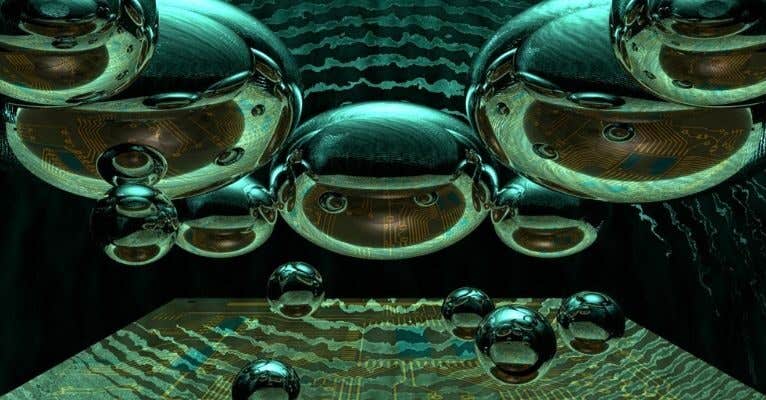Physicists use 5,564-qubit quantum computer to model the death of our universe
Scientists are exploring a phenomenon that could cause the universe to radically transform, altering its fundamental constants and structure.

Quantum mechanics would allow the Universe to eventually tunnel to the lowest energy state, or the ‘true’ vacuum, and that process would result in a cataclysmic global event. (CREDIT: Professor Zlatko Papic, University of Leeds)
Nearly 50 years ago, physicists floated a bold idea: our universe might be stuck in a false vacuum. This state feels stable, but deep down, it's not. Over enormous timescales, it could suddenly tip into a "true" vacuum, unleashing a sweeping transformation. If that ever happens, the very laws of physics could shift in an instant—and everything we know could vanish.
For decades, scientists struggled to study this terrifying possibility. Quantum field theory, the framework needed to understand it, is famously hard to work with. But now, new progress has come from a global research team. Led by scientists from the University of Leeds, Forschungszentrum Jülich in Germany, and the Institute of Science and Technology Austria (ISTA), the group used a novel tool to simulate this dramatic transition.
Their tool of choice: a quantum annealer. Unlike classical computers, this device is built to solve complex optimization problems by mimicking the behavior of quantum systems. By tapping into its unique capabilities, the team created a rare window into the mechanics of false vacuum decay.
“We're talking about a process by which the universe would completely change its structure,” said Professor Zlatko Papic, a theoretical physicist at Leeds. “The fundamental constants could instantaneously change, and the world as we know it would collapse like a house of cards.”
Quantum Bubbles and The Power of Supercomputers
To simulate the decay, the team focused on how quantum bubbles form in a false vacuum. These aren't ordinary bubbles—they're quantum ones. Just like steam bubbles in water below boiling point, these true vacuum bubbles can appear and grow, reshaping space itself. As they expand and collide, the false vacuum breaks down, ushering in a new phase of the universe.
The researchers used a D-Wave quantum annealer equipped with 5,564 superconducting flux qubits, linked through the Jülich UNified Infrastructure for Quantum computing (JUNIQ). By arranging these qubits in a circular pattern, they recreated a quantum Ising model, which mimics magnetic forces at the tiniest scales. Adjusting the system’s parameters let them kickstart and track how a false vacuum might collapse.
Related Stories
Dr. Jean-Yves Desaules, a researcher at ISTA, offered a vivid analogy. Imagine a rollercoaster with several valleys. “If that is indeed the case,” he explained, “quantum mechanics would allow the Universe to eventually tunnel to the lowest energy state, or the ‘true’ vacuum, and that process would result in a cataclysmic global event.”
The quantum annealer provided a unique opportunity to study bubble formation and interactions in real time. Instead of isolated quantum tunneling events, researchers observed a complex dynamic in which bubbles influenced each other, with larger bubbles absorbing smaller ones in a process resembling a "quantum dance." This insight could help refine theories about how these transitions occurred in the early universe.
Breakthroughs in Quantum Simulation
Simulating false vacuum decay at such a large scale represents a significant leap in quantum research. Until now, studying these processes relied on theoretical calculations that were difficult to validate. The experiment allowed researchers to directly observe how bubbles evolve, a breakthrough that could redefine how scientists approach quantum phase transitions.
The study also sheds light on a key concept known as the Kibble–Zurek mechanism, which describes how phase transitions generate defects and fluctuations in a system.
The team’s observations confirmed theoretical predictions about how false vacuum decay proceeds, reinforcing the idea that quantum fluctuations play a crucial role in shaping the universe’s structure.
Dr. Jaka Vodeb, a researcher at Forschungszentrum Jülich, emphasized the potential of quantum annealers in physics: “By leveraging the capabilities of a large quantum annealer, our team has opened the door to studying non-equilibrium quantum systems and phase transitions that are otherwise difficult to explore with traditional computing methods.”
In addition to its cosmological significance, the research has implications for advancing quantum computing. The ability to simulate quantum field theories using annealers could lead to breakthroughs in materials science, cryptography, and artificial intelligence.
From the Universe to Real-World Applications
While the prospect of false vacuum decay reshaping the universe is intriguing, the study’s real-world impact extends beyond cosmology. Researchers believe insights from bubble interactions in quantum systems could improve quantum computing performance by refining how qubits manage errors and process information.
The team also demonstrated how tabletop experiments with quantum devices could replace massive high-energy physics facilities like the Large Hadron Collider in some cases. Professor Papic highlighted the significance of these findings: “It’s exciting to have these new tools that could effectively serve as a laboratory to understand the fundamental dynamical processes in the Universe.”
The research, funded by the UKRI Engineering and Physical Sciences Research Council (EPSRC) and the Leverhulme Trust, underscores how fundamental physics can intersect with technological innovation.
Dr. Kedar Pandya, EPSRC’s Executive Director for Strategy, noted, “Curiosity-driven research is a critical part of the work EPSRC supports. This project is a great demonstration of that work, with ideas from fundamental quantum physics coming together with technological advances in quantum computing to help answer deep questions about the nature of the Universe.”
As quantum technology continues to evolve, the ability to simulate and manipulate fundamental processes like vacuum decay could open new frontiers in physics. While the universe’s fate remains uncertain, this research provides a new way to explore its mysteries, bringing theoretical physics one step closer to reality.
What is a "vacuum" in physics?
In quantum field theory, the vacuum isn't just "nothing"—it's the lowest-energy state of all the fields (like the electromagnetic field, Higgs field, etc.). Even when there's no matter or light, such as parts of deep space, these fields still exist and have a specific arrangement and energy level.
Physicists believe our universe may be in a "false vacuum"—a state that appears stable but isn't the lowest possible energy level of the underlying quantum fields that shape reality. A "true vacuum" would be a deeper, more stable state of those fields. But the vacuum isn’t just empty space; it’s the foundation that determines how particles behave, what forces exist, and how stable matter is.
If our vacuum were to suddenly shift to a true vacuum, it would reset the rules of physics everywhere the change spreads. Fundamental constants like the speed of light, the strength of gravity, or the electron’s charge are all tied to the vacuum’s structure. A shift would likely mean atoms could no longer form, electrons wouldn’t orbit nuclei, and the chemistry that supports stars, planets, and life itself would break down.
Analogy: Changing the rules of the game
Imagine you're playing chess on a particular board with a specific set of rules. The "vacuum state" is like the rules of the game. If you suddenly change the rules (say, bishops now move like knights), then every piece on the board behaves differently—even if some parts of the board are empty.
Vacuum decay is like replacing the rules of physics. All atoms, everywhere, would be affected instantly as the new "true vacuum" bubble expands.
Research findings are available online in the journal Nature Physics.
Note: Materials provided above by The Brighter Side of News. Content may be edited for style and length.
Like these kind of feel good stories? Get The Brighter Side of News' newsletter.



